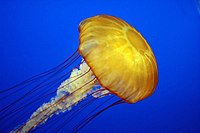
Photo from wikipedia
Anthropogenic disturbances may be increasing jellyfish populations globally. Epibenthic jellyfish are ideal organisms for studying this phenomenon due to their sessile lifestyle, broad geographic distribution, and prevalence in near-shore coastal… Click to show full abstract
Anthropogenic disturbances may be increasing jellyfish populations globally. Epibenthic jellyfish are ideal organisms for studying this phenomenon due to their sessile lifestyle, broad geographic distribution, and prevalence in near-shore coastal environments. There are few studies, however, that have documented epibenthic jellyfish abundance and measured their impact on ecological processes in tropical ecosystems. In this study, the density and size of the upside-down jellyfish (Cassiopea spp.) were measured in Codrington Lagoon, Barbuda. A sediment core incubation study, with and without Cassiopea, also was performed to determine their impact on benthic oxygen and nutrient fluxes. Densities of Cassiopea were 24-168 m-2, among the highest reported values in the literature. Under illuminated conditions, Cassiopea increased oxygen production >300% compared to sediment alone, and they changed sediments from net heterotrophy to net autotrophy. Cassiopea increased benthic ammonium uptake, but reduced nitrate uptake, suggesting they can significantly alter nitrogen cycling. Future studies should quantify the abundance of Cassiopea and measure their impacts on ecosystem processes, in order to further determine how anthropogenic-related changes may be altering the function of tropical coastal ecosystems.
Journal Title: Marine environmental research
Year Published: 2020
Link to full text (if available)
Share on Social Media: Sign Up to like & get
recommendations!